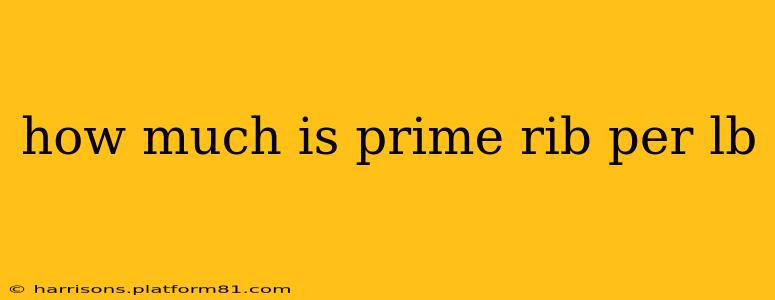The price of prime rib per pound can vary significantly depending on several factors. There's no single definitive answer, but understanding these influencing elements will help you budget effectively and get the best value for your money. This guide breaks down the cost, explores contributing factors, and helps you make informed decisions when purchasing this luxurious cut of beef.
What Factors Influence Prime Rib Price Per Pound?
Several key factors contribute to the fluctuating price of prime rib:
-
Grade of Beef: The grade of beef directly impacts the price. Prime grade beef, the highest quality, commands the highest price per pound. Choice and Select grades are lower in quality and consequently less expensive. Prime rib from a Prime-graded steer will be significantly more expensive than one from a Choice-graded animal.
-
Location: Geographic location plays a crucial role. Prime rib prices can differ widely between rural areas with local butchers and urban areas with higher operating costs and potentially a wider selection of imported meats. Grocery stores in different parts of the country may also have varying prices due to local market conditions and transportation costs.
-
Retailer: The retailer you choose significantly influences the price. High-end butcher shops specializing in premium cuts will often charge more than large grocery store chains. Smaller, local butcher shops might offer a balance between quality and price.
-
Time of Year: Demand fluctuates throughout the year. Holiday seasons like Thanksgiving and Christmas often see increased demand and, therefore, higher prices for prime rib.
-
Bone-In vs. Boneless: Bone-in prime rib generally costs slightly less per pound than boneless prime rib, but the bone adds flavor and moisture during cooking. The boneless option is often more convenient for carving and serving.
-
Weight: The weight of the roast also influences the price per pound. Larger roasts sometimes have a slightly lower price per pound than smaller ones due to economies of scale for the retailer. However, it’s important to consider how much you will realistically need.
How Much Can I Expect to Pay?
While precise pricing is impossible to state, here's a general range you can expect:
- Prime Grade, Bone-In: You can anticipate paying anywhere from $15 to $30+ per pound, depending on the factors listed above.
- Prime Grade, Boneless: Prices for boneless prime rib often fall within a similar range, but may be slightly higher due to the extra labor involved in removing the bone.
- Choice Grade: Choice grade prime rib will typically be significantly cheaper, possibly in the range of $10-$20 per pound, but the quality and flavor will differ noticeably.
Remember: These are broad estimates. To get an accurate price, check with your local butcher or grocery store.
Where Can I Find the Best Deals on Prime Rib?
- Shop Around: Comparing prices from different retailers is crucial. Check local butcher shops, larger grocery stores, and even warehouse clubs for the best deals.
- Look for Sales: Grocery stores and butchers frequently run sales, especially on less popular cuts or during off-peak seasons.
- Buy in Bulk (If Needed): Buying a larger roast can sometimes lower the price per pound, but only do this if you know you'll use the entire roast before it spoils.
- Consider Alternatives: If prime rib is too expensive, consider less expensive but still delicious cuts like ribeye steaks or chuck roast.
What are the best cuts of prime rib?
The optimal cut depends on your preferences and cooking method. There are many variations that are similar and are referred to as prime rib, often with a more specific name that identifies the cut's position on the rib section.
What's the difference between prime rib and standing rib roast?
Prime rib and standing rib roast are often used interchangeably. Technically, "standing rib roast" refers to a specific cut from the rib section of beef, while "prime rib" generally refers to a high-quality standing rib roast from a prime-grade steer. Essentially, you're looking at the same product, but one has quality implications, while the other is the descriptive term for the cut.
By understanding these factors and actively comparing prices, you can find the perfect prime rib roast within your budget and enjoy a delicious meal. Remember to factor in the cost of sides and other ingredients to get a complete picture of the total meal cost.
